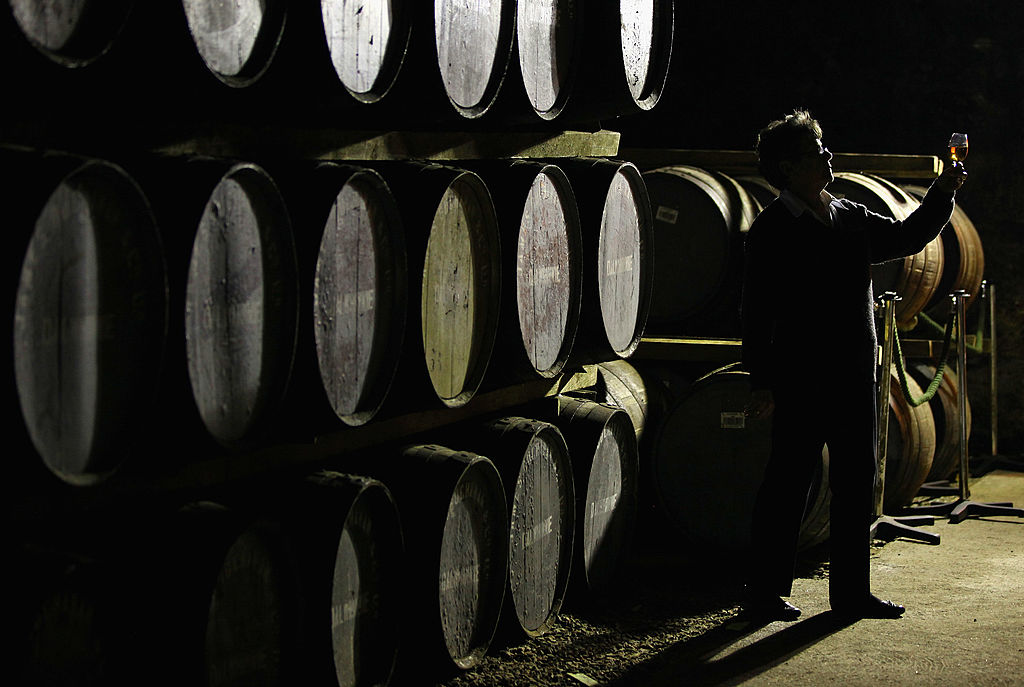“The light music of whiskey falling into a glass — an agreeable interlude.” – James Joyce
Nomenclature is important in the world of alcohol. Terms matter. Confuse a digestif and an aperitif at your peril. So let’s start this conversation by noting that “whiskey” is made in Ireland and the USA and “whisky” is made everywhere else. The word “spirit” also has a long and deep history. Middle Eastern alchemists believed their distillations were leaving the spirit of the grain behind. Traveling monks passed the spirit of Jesus onto believers when they doled out sacraments at medieval services in order to bolster church numbers. Those monks were serving their early followers aqua vitae, literally the “water of life.”
When the monks’ travels took them to medieval Ireland, that spirit evolved into whiskey. Surely all of our souls are better for it.
In keeping with our desire to help you up your game with regards to all things alcohol, our latest guide to Gateway Drinks guide is taking on Irish Whiskey. Let’s look at how some wandering monks deliver this incredible elixir to the world.
IRELAND AND JESUS
“What whiskey will not cure, there is no cure for.” – Irish Proverb
The word whiskey is a direct Anglicization of the Irish Gaelic uisce beatha — roughly pronounced ooshkay bedah. It’s a direct translation of aqua vitae. Uisce morphed into the word whiskey as time went on and English became the prominent language in Ireland. Try pronouncing uisce like Sean Connery a couple times and you’ll likely end up saying whiskey after a few tries. Especially if you’ve had a few sips of the stuff.
Italian monks borrowed the process of distillation from the Islamic enlightenment era Arabs who, in turn, refined the practice from Greek and Chinese alchemists. Those Italian monks had been brewing beer and barreling wine for centuries, but the addition of distillation meant they could distill that wine into brandy — which got them way drunker way faster. They called their concoction aqua vitae and it was a cornerstone of the sacrament in medieval days. Around 1000CE, Irish and Italian monks were traveling back and forth from Ireland and Rome to help bolster the religion’s hold in converting the Celtic pagans of the British Isles — it was a recipe for cultural exchange.
Peter Mulryan points out in The Whiskeys of Ireland that this traveling meant that distillation was brought to Ireland sometime between 1000 and 1200, possibly to start making perfumes at first, but definitely to start distilling grains, too. The area lacked barrels for aging (again, no wine culture) so aging in barrels was not a necessary component of whiskey yet. Imagine a product a lot closer to undiluted vodka or Everclear than anything remotely close to a whiskey we drink today.
The distilling of whiskey started first in Ireland, since monks arrived there earlier than the Scotland, much to the chagrin of Scottish whisky lovers and advocates. However looking back on the history, the lag between the two was short enough that you may as well say they got whiskey about the same time. What’s a hundred years here and there between millenniums?
The first known written word about whiskey is also from Ireland. The Irish historical tome Annals of Clonmacnoise covered Ireland’s history up to 1408. It recounts a story from 1405 when a chieftain took “a surfeit” of whiskey around Christmas time and died from it. Even though the first written record of whiskey was how it killed you, it did not deter anyone from drinking it.
The monastic orders were the only distillers of uisce beatha for a good long time. Today, a Catholic sacrament is a sip of wine, back then — to get pagans on board and keep the flock flocking back — it was a good belt of grain spirits. Now imagine you’re a person who has never really had any alcohol except for maybe some really watery beer you boiled up last summer and then suddenly you’re doing shots with a friar. Can you really blame people for seeing Jesus and finding faith? Then add to that that the only place you can get that heady, warm, delightful buzz was back at the church.
Ireland became and still is very catholic. Whiskey is at least partially to thank.
The spirit was taken up as a medicinal cure (because of course it was) and The Guild Of Surgeon Barbers were granted access to the distillation industry through the first licensing of whiskey in 1556 at the parliament at Drogheda. In a world were barbers were the surgeons, getting sh*tfaced on whiskey before going under the knife must have made the whole nightmarish process a little easier, and likely deadlier. Thin blood isn’t great for those getting sliced to ribbons by a bunch of barbers.
Either way, this was the first step to getting uisce out of the rectory and into the pub — which meant it was open to the public to start tinkering.
THE BRITISH EMPIRE
“Too much of anything is bad, but too much good whiskey is barely enough.” – Mark Twain
By 1608, the first official license was issued for a whiskey distillery in Bushmills, County Antrim in what’s now Northern Ireland. Over the course of the next century, heavy taxes and laws would prevent whiskey from blowing up across the ever-growing British empire.By 1620, the Irish were forced by their British overlords (Ireland was indirectly under English control since 1494 and directly from 1542 onwards) to issue a warning that whiskey was likely to kill you. It didn’t matter, people were still into the stuff.
A generation passed and whiskey was still being imbibed habitually around Ireland. On Christmas Day 1661, the British levied the largest tax yet on Irish whiskey. This sent many distillers underground, so to speak. They’d run their stills at night to avoid detection from tax collectors. This practice of distilling by the shine of the moon led to the rebel distillers earning the nickname “moonshiners.” It’s worth noting that Scotland was going through a similar process of restriction and subversion due to whisky’s perceived societal ills. The taxes were so heavy in Scotland by 1725 that most legal stills were shuttered.
https://www.instagram.com/p/BDDqHsyCGgK/
During the 1700s, moonshiners and legal, tax-paying distillers fractured the Irish market into “parliament whiskey” which was taxed and often adulterated and watered down for public health, and poitín which was 100% illegal and the real deal. This war between the whiskey distillers and British empire lasted about 150 years. But it was this war on whiskey that got us one step closer to whiskey as we know it today.
To hide the spirit from nosy tax detectives, the grain alcohol was stored in barrels, often hidden in dank cellars. That clear white lightening suddenly became something else entirely. Up until that point, casking or barreling only happened when you wanted to transport a spirit or wine for long distances. Since most stills were local, whiskey rarely ever needed to be casked. In fact, most whiskey was stored in buckets or bottled directly from the still.
At the same time Irish (and Scottish) migrants to the the New World started distilling their own spirits when they arrived in the Americas with local grains and cereals, like rye and corn, which led to the rise of American whiskeys and bourbons.
Around 1850, whiskey was standardized by region and brand. Irish whiskey’s single malt is always barley which is steeped in water to activate enzymes in the grain. Next, the barley is kilned to prevent the grains from using up too much starch. This is done by drying the grains on metal racks over a fire. And that’s where Irish whiskey and Scottish whisky diverge. Irish whiskey is almost always distilled three times. This was born out of the Irish wanting to distinguish themselves from Scotch whisky during the 1800s. At the time, Scotch was being distilled at fairly low standards in old Coffey stills. Ireland decided to corner the market and produce a superior product to drive out the Scotch export market to America. Hence triple distilling — which amps up the purity of the product with each distillation.
Irish whiskey would take a couple huge blows in the 20th century that it has yet to recover from. In early 1800, a man named Aeneas Coffey (inventor of the Coffey still) started making pure grain alcohol, which was cheaper than whiskey, and selling it to pubs. Distillers were not happy about this. Coffey stills were cheap, brute, and produced a product Irish whiskey distillers did not want their product associated with. This led to the “What Is Whiskey?” case of 1909 which the courts declared that any grain distillation could be called whiskey. Distillers were furious. As a result, “blending” grew rapidly (it’s still a huge part of what whiskey is to this day).
Initially, the ability to adulterate whiskey with cheaper and invariably lower quality grain alcohol gave rise to an inferior product that produced inferior results. This then gave rise and ammunition to the Temperance Movement — and, ho-boy, they hated drinking and weren’t afraid to show it. And this led to the disaster that was American Prohibition.
THE REPUBLIC OF IRELAND
“Whisky is liquid sunshine.” – George Bernard Shaw
Because of the Irish march to independence from 1916 to 1921, the British set up a trade embargo on Irish products which was not fully lifted until Ireland’s ascension into the European Union in the 1970s. The same year that the embargo started, American Prohibition began. Suddenly Ireland’s biggest whiskey importer was gone — the illegal import of Irish whiskey still occurred, but at a much lower rate.
Ireland went from Europe’s biggest whiskey exporter in 1900 to a very distant third fiddle by 2000. Scotland never suffered the same trade embargo as Ireland and was able to amp up export of Scotch when America came to its senses and ended prohibition in 1933. Another boon for Scotch was WWII American GIs coming back from the UK with a taste for all the Scotch whisky they drank while ‘over there.’
All of this added up to Ireland losing half of its 21,000 pubs and all but 12 of its 88 licensed and roughly 2,000 un-registered distilleries.
Today, Ireland produces 7 million cases of whiskey annually. Of that, 4.5 million is Jameson alone. By comparison, Scotland exports 99 million cases per year. That British embargo — that they had to lift because of Ireland’s ascension into the EU — still haunts Irish whiskey. They’ve yet to fully recover.
Over the course of the 19th and 20th century Irish whiskey standardized (along with the rest of the world’s spirits). Irish whiskey is now broken into four categories: Single Malt Irish Whiskey, Single Pot Whiskey, Grain Whiskey, and Blended Whiskey.
Single Malt is a malted barley distilled in a pot still. This is the closest to Scotch Single Malt, only that it’s almost always triple distilled in Ireland and only (again, usually) twice distilled in Scotland. The best bottles you’ll find are Connemara Peated Malt, Bushmills 10, 16, and 21 years, Locke’s Single Malt, and Tullamore D.E.W Single Malt 10 year.
Single Pot is a mixture of malted and unmalted barley distilled in a pot still. Often the whiskey will tell you on the label that it’s a pot whiskey but not always. Decent bottles to try are Yellow Spot, Green Spot, Redbreast, and Power’s Three Swallows.
https://www.instagram.com/p/4uMxZgQa-H/
Grain whiskey is made by a continuous distillation in a column or Coffey still from a variety of grains. More often than not, these whiskeys are used for blended whiskeys, so finding one isn’t always easy. However, there are Single Grain Whiskeys on the market, Teeling’s Single Grain being the most common.
Blended Whiskey is the most common form of Irish whiskey you’ll find. Basically it’s a blend of any and all of the above types of Irish whiskey. This is Jameson, Busmills, Tullamore D.E.W, Power’s, Paddy, Black Bush, etc. That’s not to say that each of those distillers don’t also make single malts or single grains, they often do. But the average bottle of Irish whiskey is going to be a blend — this is also true of the vast majority of Scotch whisky sold on the open market.
https://www.instagram.com/p/BQN682fBFvR/
Extra credit: Poitín has started making a comeback. It’s probably the closest version of whiskey to the original version drunk for centuries across Europe, before the era barreling. Poitín is made with a single malt of barley in pot still and simply not barreled.
Let’s end on some good news. Ireland’s whiskey industry is growing extremely fast. There are five new distilleries in recent years and plans for another dozen in the near future. That 7 million cases sold in 2015 is up from 4 million cases sold in 2008, and the market is expected to expand to 24 million cases by 2030, putting it on par with Canada.
So expect to see a lot more Irish whiskey on the shelf in the very near future. It’s a spirit with a fascinating history, well deserving of a spot on your shelf.







